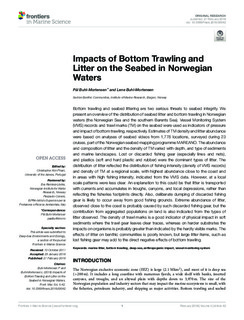| dc.description.abstract | Bottom trawling and seabed littering are two serious threats to seabed integrity. We present an overview of the distribution of seabed litter and bottom trawling in Norwegian waters (the Norwegian Sea and the southern Barents Sea). Vessel Monitoring System (VMS) records and trawl marks (TM) on the seabed were used as indicators of pressure and impact of bottom trawling, respectively. Estimates of TM density and litter abundance were based on analyses of seabed videos from 1,778 locations, surveyed during 23 cruises, part of the Norwegian seabed mapping programme MAREANO. The abundance and composition of litter and the density of TM varied with depth, and type of sediments and marine landscapes. Lost or discarded fishing gear (especially lines and nets), and plastics (soft and hard plastic and rubber) were the dominant types of litter. The distribution of litter reflected the distribution of fishing intensity (density of VMS records) and density of TM at a regional scale, with highest abundance close to the coast and in areas with high fishing intensity, indicated from the VMS data. However, at a local scale patterns were less clear. An explanation to this could be that litter is transported with currents and accumulates in troughs, canyons, and local depressions, rather than reflecting the fisheries footprints directly. Also, deliberate dumping of discarded fishing gear is likely to occur away from good fishing grounds. Extreme abundance of litter, observed close to the coast is probably caused by such discarded fishing gear, but the contribution from aggregated populations on land is also indicated from the types of litter observed. The density of trawl marks is a good indicator of physical impact in soft sediments where the trawl gear leaves clear traces, whereas on harder substrates the impacts on organisms is probably greater than indicated by the hardly visible marks. The effects of litter on benthic communities is poorly known, but large litter items, such as lost fishing gear may add to the direct negative effects of bottom trawling. | nb_NO |
